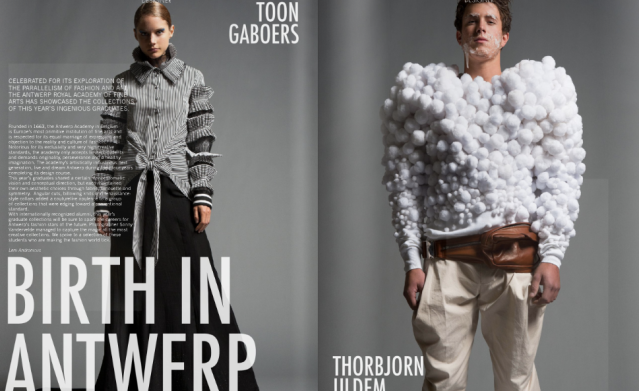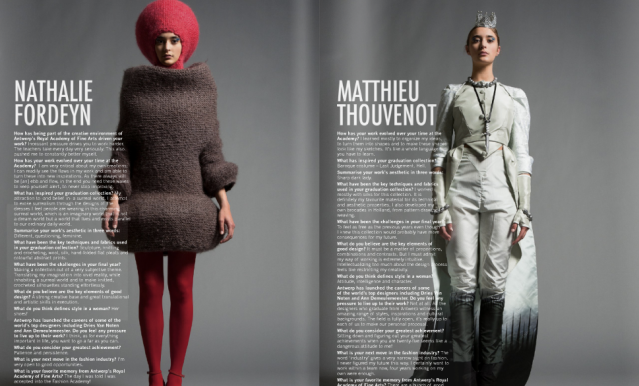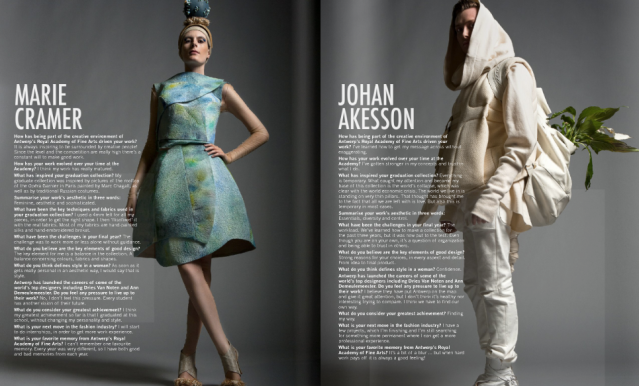Page 20 of Tangent Magazine Issue 4 'UNLIMITED'
Words: Leni Andronicos



CELEBRATED FOR ITS EXPLORATION OF THE PARALLELISM OF FASHION AND ART, THE ANTWERP ROYAL ACADEMY OF FINE ARTS HAS SHOWCASED THE COLLECTIONS OF THIS YEAR’S INGENIOUS GRADUATES.
Founded in 1663, the Antwerp Academy in Belgium is Europe’s most primitive institution of fine arts and is respected for its equal marriage of expression and objection to the reality and culture of fashion. Notorious for its exclusivity and very high creative standards, the academy only accepts limited students and demands originality, perseverance and a healthy imagination. The academy’s artistically industrious next generation, live and dream Antwerp during their four years completing its design course. This year’s graduates shared a certain monochromatic vision and conceptual direction, but each maintained their own aesthetic choices through fabric, silhouette and symmetry. Angular cuts, billowing knits and renaissance- style collars added a couturelike opulence to a group of collections that were edging toward a conventional standard. With internationally recognized alumni, this year’s graduate collections will be sure to spark the careers for Antwerp’s fashion stars of the future. Photographer Sonny Vandervelde managed to capture the magic of the most creative collections as we speak to a selection of these students who are making the fashion world tick.
NATHALIE FORDEYN
How has being part of the creative environment of Antwerp’s Royal Academy of Fine Arts driven your work? Incessant pressure drives you to work harder. The teachers take every day very seriously. This also pushed me to constantly better myself.
How has your work evolved over your time at the Academy? I am very critical about my own creations; I can readily see the flaws in my work and am able to turn these into new inspirations. As there always will be [an] ebb and flow, in the end you need these waves to keep yourself alert, to never stop improving.
What has inspired your graduation collection? My attraction to -and belief in- a surreal world. I attempt to evoke surrealism through the designs of the dresses I feel people are wearing in this charming surreal world, which is an imaginary world that is not a dream world but a world that lives and exists parallel to our ordinary daily world.
Summarise your work’s aesthetic in three words:Different, questioning, feminine.
What have been the key techniques and fabrics used in your graduation collection? Sculpture, knitting and crocheting, wool, silk, hand-folded flat pleats and colourful abstract prints.
What have been the challenges in your final year?Making a collection out of a very subjective theme. Translating my imagination into vivid reality, while inhabiting a surreal world and to make knitted, crocheted silhouettes standing effortlessly.
What do you believe are the key elements of good design? A strong creative base and great translational and artistic skills in execution.
What do you think defines style in a woman? Her shoes!
Antwerp has launched the careers of some of the world’s top designers including Dries Van Noten and Ann Demeulemeester. Do you feel any pressure to live up to their work? I think, as for everything important in life, you want to go a far as you can.
What do you consider your greatest achievement?Patience and persistence.
What is your next move in the fashion industry? I’m very open to good opportunities.
What is your favorite memory from Antwerp’s Royal Academy of Fine Arts? The day I was told I was accepted into the Fashion Academy!
MATTHIEU THOUVENOT
How has your work evolved over your time at the Academy? I learned mostly to organize my ideas, to turn them into shapes and to make these shapes look like my sketches. It’s like a whole language you have to learn.
What has inspired your graduation collection? Baroque costume – Last Judgement. Hell.
Summarise your work’s aesthetic in three words:Sharp dark lady.
What have been the key techniques and fabrics used in your graduation collection? I worked mostly with silks for this collection. It is definitely my favourite material for its technical and aesthetic properties. I also developed my own brocades in Holland, from pattern drawing to weaving.
What have been the challenges in your final year?To feel as free as the previous years even though I knew this collection would probably have more consequences for my future.
What do you believe are the key elements of good design? It must be a matter of proportions, combinations and contrasts. But I must admit my way of working is extremely intuitive. Intellectualizing too much about the design process feels like restricting my creativity.
What do you think defines style in a woman?Attitude, intelligence and character.
Antwerp has launched the careers of some of the world’s top designers including Dries Van Noten and Ann Demeulemeester. Do you feel any pressure to live up to their work? Not at all. All the designers who graduate from Antwerp witness an amazing range of styles, inspirations and cultural backgrounds. The field is fully open, it’s really up to each of us to make our personal proposal.
What do you consider your greatest achievement?Sitting down and figuring out your greatest achievements when you are twenty-five seems like a dangerous attitude to me!
What is your next move in the fashion industry? The word ‘industry’ gives a very narrow sight on fashion. I never figured my future this way. I certainly want to work within a team now, four years working on my own were enough.
What is your favorite memory from Antwerp’s Royal Academy of Fine Arts? There are a bunch of good memories … It was such an intense experience … Looking back it seems difficult to divide the good from the bad. I want to keep it all!
MARIE CRAMER
How has being part of the creative environment of Antwerp’s Royal Academy of Fine Arts driven your work? It is always inspiring to be surrounded by creative people! Since the level and the competition are really high there’s a constant will to make good work.
How has your work evolved over your time at the Academy? I think my work has really matured.
What has inspired your graduation collection? My graduate collection was inspired by pictures of the rooftop of the Opéra Garnier in Paris painted by Marc Chagall, as well as by traditional Russian costumes.
Summarise your work’s aesthetic in three words:Feminine, aesthetic and sophisticated.
What have been the key techniques and fabrics used in your graduation collection? I used a 4mm felt for all my pieces, in order to get the right shape. I then ‘flisofixed’ it with the real fabrics. Most of my fabrics are hand-painted silks and hand-embroidered brokat.
What have been the challenges in your final year? The challenge was to work more or less alone without guidance.What do you believe are the key elements of good design?The key element for me is a balance in the collection. A balance concerning colours, fabrics and shapes.
What do you think defines style in a woman? As soon as it gets really personal in an aesthetic way, I would say that is style.
Antwerp has launched the careers of some of the world’s top designers including Dries Van Noten and Ann Demeulemeester. Do you feel any pressure to live up to their work? No, I don’t feel this pressure. Every student has another vision of their future.
What do you consider your greatest achievement? I think my greatest achievement so far is that I graduated at this school, without changing my personality and style.
What is your next move in the fashion industry? I will start to do internships, in order to get more work experience.
What is your favorite memory from Antwerp’s Royal Academy of Fine Arts? I can’t remember one favourite memory. Every year was very different, so I have both good and bad memories from each year.
JOHAN AKESSON
How has being part of the creative environment of Antwerp’s Royal Academy of Fine Arts driven your work? I’ve learned how to get my message across without exaggerating.
How has your work evolved over your time at the Academy? I’ve gotten stronger in my concepts and trust in what I do.
What has inspired your graduation collection? Everything is temporary. What caught my attention and became my base of this collection is the world’s collapse, which was clear with the world economic crisis. The world we live in is standing on very thin pillars. That thought has brought me to the fact that all we are left with is love. But also this is temporary in most cases.
Summarise your work’s aesthetic in three words:Essentials, diversity and control.
What have been the challenges in your final year? The workload. We’ve learned how to make a collection for the past three years, but it was now put to the test. Even though you are on your own, it’s a question of organization and being able to trust in others.
What do you believe are the key elements of good design?Strong reasons for your choices, in every aspect and detail. From idea to final product.
What do you think defines style in a woman? Confidence.
Antwerp has launched the careers of some of the world’s top designers including Dries Van Noten and Ann Demeulemeester. Do you feel any pressure to live up to their work? I believe they have put Antwerp on the map and give it great attention, but I don’t think it’s healthy nor interesting trying to compare. I think we have to find our own way.
What do you consider your greatest achievement? Finding my way.
What is your next move in the fashion industry? I have a few projects, which I’m finishing and I’m still searching for something more permanent where I can get a more professional experience.
What is your favorite memory from Antwerp’s Royal Academy of Fine Arts? It’s a bit of a blur … but when hard work pays off it is always a good feeling!
See the full piece online at www.tangentmag.com
No comments:
Post a Comment